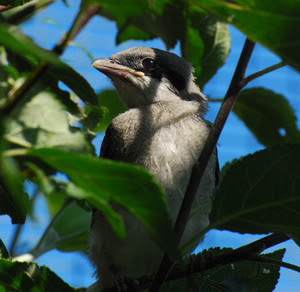Solar Farms in Shrike Country

By Leanne Grieves and Hazel Wheeler Wildlife Preservation Canada
One of the interesting challenges of modern-day conservation is that it’s no longer enough simply to get people to switch from unsustainable practices to greener ones. The problem now is that there are simply so many of us, with such great needs, that our footprint on the ecosystem is almost unavoidable, even when we try to do the right thing. Thus it is that one of the newest potential threats to the survival of the eastern loggerhead shrike comes with the best of intentions.
Perhaps one of the fastest-growing new technologies, expanding by 50% over the past decade, solar photovoltaics (PV) are frequently considered one of the greenest energy sources, with high potential for generating fossil-free energy. PV systems use solar panels to convert solar energy into direct current electricity. Small-scale or personal-use PV systems are very environmentally friendly, as they can often be installed on rooftops so don’t require extra space. To produce energy on a commercial scale, however, requires larger-scale solar farms. These farms generally have panels installed on motorized towers that track the sun, and they can be quite extensive, consisting of thousands of panels covering over 100 acres.
This raises important concerns about the impact of solar farms on natural habitats. For example, research suggests that land-use changes resulting from solar farms could result in changes in the micro-climate, such as humidity levels, wind flow, temperature and rainfall distribution. The impact of this on soil and plants, and how it will ultimately affect carbon storage and cycling, which are tied into greenhouse gas emissions, are currently unknown.
Perhaps an unforeseen consequence of solar farms is the threat they pose to wildlife, particularly birds, due to the “lake effect”—the arrangement of solar panels can give the appearance of a smooth body of water, and birds attempting to land die as a result of the collision. This illusion also affects invertebrates, a concern both in its own right and because invertebrates are an important food source for many bird species, including the loggerhead shrike.
And of course, there is the issue of habitat loss, since grasslands are often prime areas for solar farm development. This is an issue of growing importance in Carden and Napanee—the only areas remaining in Ontario where the critically endangered loggerhead shrike still reliably breeds. There are already a number solar farms in these regions, and more proposals coming each year. In 2015 alone, ten solar farm proposals were submitted in the City of Kawartha Lakes (which includes Carden). While policies dictate that solar farms be constructed in brownfields and low-quality agricultural lands, many of these farms are situated on or near existing shrike habitat, which is also important for many other grassland-nesting birds including other species-at-risk, such as bobolink and eastern meadowlark.
With so few loggerhead shrikes left in Ontario, every piece of habitat is important. Green energy is, of course, also important, but the issues we continue to see highlight that while solar is certainly an improvement over fossil fuel-based energy sources, we still have some work to do before this new energy source can sincerely be called “green”, in all the ways it should be.









Leave a Reply